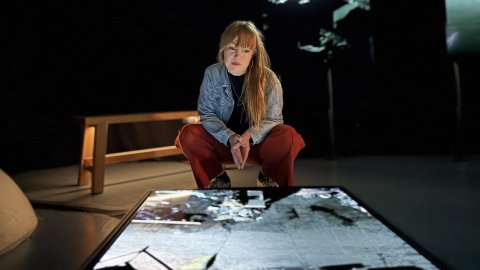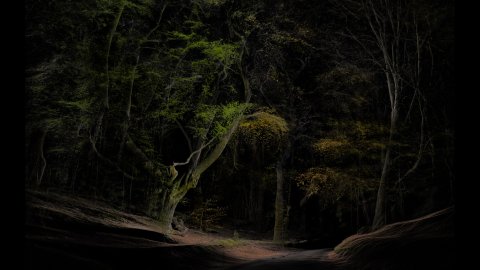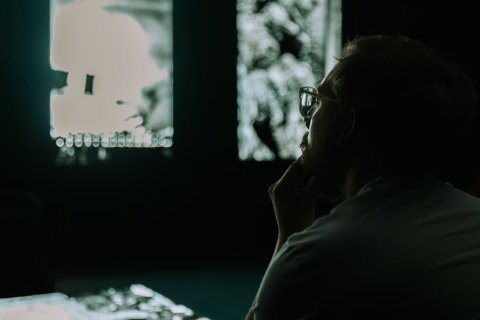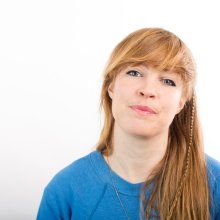
Amy Rose Lead Curator, Undershed
on Mon 7 July 2025Taking a position in an overwhelming world
Posted on Mon 7 July 2025
In this article Amy Rose, Lead Curator of Undershed shares her reflections on FRAMERATE: Pulse of the Earth which will run until Sun 13 July.
The tide rolls in and out. Corn flutters into being. Ghostly figures flicker and disappear. Flowing from one scene into the next, awash among moving images around, beneath and above - the experience of being in and amongst FRAMERATE: Pulse of the Earth is profoundly tidal.
Matt Shaw and William Trossell began trying to scan rainbows and controlled explosions in 2013. Seeking the noisy edges of the imagery and the places that these giant raw data sets stop making sense – as ScanLAB Projects, they have meticulously built up a substantial body of work in collaboration with many other artists and makers. The process behind all of that work uses a combination of LiDAR scanners and other new techniques of photography – seeking an aesthetic that leans towards the future at the same time as somehow retaining a sense of the ghostly past, with echoes of maps, architectural diagrams and the traces left behind by human activity.
Once a LiDAR scanner is set in position, it shoots out millions of laser pulses in all directions, creating a 3D replica, or digital twin, of the place. You can then look at this 3D space from any position – up in the air, down on the ground, at a very specific stone, etc. You could also use this 3D replica to make an environment to be explored in a video game or in Virtual Reality.
FRAMERATE: Pulse of the Earth turns multiple versions of these digital 3D maps into 2D films that chart the passage of time, with various points in space chosen by the artists to be seen in the artwork.

“For the first five, six, seven years of ScanLAB, we were documenting these single frozen moments in time. You know, the scanner has an exposure a little bit like an old camera, so it can take anywhere from one and a half minutes to like five hours to document a single scene. That means you're locking time - documenting this singular 3D moment. LiDAR is used for surveys - to understand the form of a space before some sort of design intervention happens. But LiDAR is also the way that your mobile phone is starting to understand the world around you in three dimensions. LiDAR is the way that autonomous vehicles map streets as they move through them. Every autonomous vehicle will, someday, be the cartographer of the future – documenting our world at 25 frames a second as it drives along the street.
We wanted to know what it would be like when those data sets exist – because they don’t exist yet. Getting out into the landscape was the way we did that. So, it is essentially a tool that was designed to enlarge our sense of spatial representation, but then we were able to turn that into a time-based medium.
Of course, it takes time to get any revelations out of a time lapse, especially a year-long time lapse. But when we first started to see these landscapes shift, we intuitively hoped it was going to be a revelatory process. The way it was holding time – in a way that you can't hold when you, as a person, are sat in one of those landscapes and even the traditional film and digital cameras cannot hold – because you’re always seeing it from the point of view of the camera."
— Matt Shaw, Director + Co-founder at ScanLAB Projects
FRAMERATE is the result of two slow years of steady graft – a small team of collaborators finding places to return to and scanning them, again and again and again. This graft is one significant half of the artistry – but the other half is the way in which those giant data sets are handled in the editing process. When you sit in amongst the screens in the dark gallery space with the images washing around you, it is easy to forget that you’re not looking at an image that was made using a drone, where the point of view was chosen at the moment of capture. What you’re actually looking at is a point of view chosen during the editing process, because the data set offers you a digital twin of the entire 3D space.

From a maker’s perspective, this is a very different proposition – moving the moment of considered choice into the calm and focused edit room, away from the potential chaos of production.
From a contemporary critical perspective, there is something interesting going on around the way in which we, as human beings, relate to the giant data sets that digital technology offers us. The acquisition of “knowledge” in the form of huge amounts of information is a dominant dynamic of our time, with data centres across the world in 2025 responsible for approximately 2% of global electricity consumption1. The question of what to do with all that information is often secondary to the acquisition process. While some contemporary investigative journalists (like Elliot Higgins of Bellingcat2) specialise in sifting through the flotsam and jetsam of available data, making sense of huge amounts of information has become an overwhelming part of everyday life.
Which begs the questions – in the constant stream of information, what do we hold onto?
As I float in the sea of shadowy rippling images of FRAMERATE, I think about the choices made to look at the world in this way – and to track the collision of human impact with the forces of nature. The points of view adopted, often from above, enabling us to gaze like future cartographers at the fragile and mutable world we inhabit. The sense of constant change, flowing like water and carrying everything along.
I am interested in how art can slow us down and offer another way of paying attention – and whether it's possible to retain this after the experience has had its way with me. After the tidal motion of FRAMERATE, I leave the building and walk out onto the Bristol harbourside – alert to the flowing movement of traffic, people, sea gulls, water, exhaust fumes, leaves on the trees. I imagine the harbourside from above, all the bodies fluttering through space, and myself, a tiny still figure sensing the passage of time around me.
“We never look at just one thing; we are always looking at the relation between things and ourselves.”
— John Berger, Ways of Seeing

